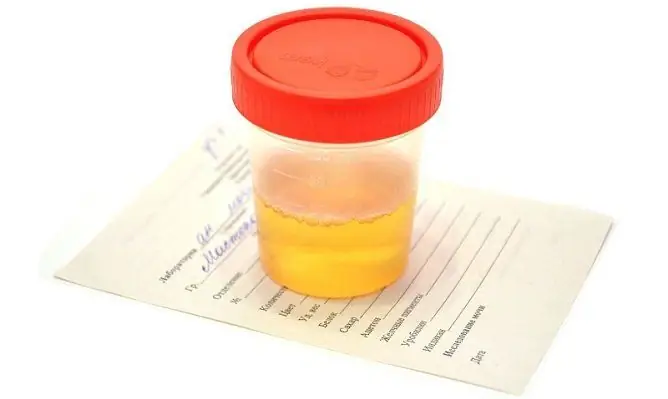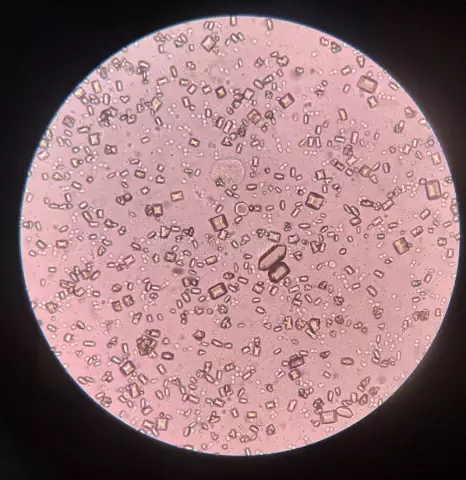- Author Rachel Wainwright [email protected].
- Public 2023-12-15 07:39.
- Last modified 2025-11-02 20:14.
How to donate urine for bacterial culture
The content of the article:
- How is the bacterial culture carried out
- Indications for bacterial sowing
- How to donate urine for bacterial culture
- Interpretation of analysis results
How to donate urine for bacterial culture is one of the frequently asked questions. This is due to the fact that many factors can distort the analysis result. To obtain reliable data, it is important to responsibly approach the preparation and follow all the recommendations.
Bacteriological examination of urine (bacteriological culture) is a type of laboratory analysis that is prescribed to identify infectious agents that cause inflammatory diseases of the kidneys and urinary tract, as well as to determine the effectiveness of treatment of infection.

Urine for bacterial culture is collected in a plastic disposable sterile container
Among the microorganisms that can cause inflammatory diseases of the urinary system, conditionally pathogenic flora is of great importance, that is, bacteria that are present in a healthy body, but can become pathogenic and actively multiply under certain conditions. Therefore, it is not enough to determine the species composition of microflora - it is also necessary to assess changes in its quantitative composition. For this, a bacteriological study of the material is carried out, during which not only the type of bacteria excreted in the urine is determined, but also their concentration. In addition, the analysis allows you to test the sensitivity of pathogenic microorganisms to antibiotics.
Before bacteriological culture, primary microscopy is performed in many laboratories - the study of urine sediment, sometimes allowing immediate identification of the pathogen. But for a more detailed study and a reliable result, a bacteriological analysis is always necessary.
How is the bacterial culture carried out
The urine sediment sample is placed on culture media that provide favorable conditions for the growth of microbial colonies. Blood agar, sugar broth and other solutions can serve as such a nutrient medium; different media are suitable for different pathogens. Most often in the laboratory, inoculation is performed on several nutrient media. The main criterion for assessing the pathogenicity of microbes is their ability to grow and multiply, that is, to form colonies, therefore the concentration of bacteria in a certain volume of urine is determined not by the number of individual bacteria, but by the number of colony-forming units - CFU. A colony forming unit is a bacterial cell from which a visible colony of microorganisms grows upon inoculation.
If a high number of bacteria is found during inoculation (10 4 or more CFU / ml), an antibiotic susceptibility test is performed. It allows you to determine which antibacterial agents are most effective in stopping the growth of colonies.
Indications for bacterial sowing
Bacteriological culture is prescribed by a general practitioner, infectious disease specialist, gynecologist or pediatrician. The indications are inflammatory diseases of the urinary tract and kidneys:
- cystitis;
- urethritis;
- pyelonephritis;
- prostatitis;
- urolithiasis disease.
The following symptoms may be the basis for bacteriological examination of urine:
- burning sensation, pain when urinating;
- increased urge to urinate;
- discharge from the urethra;
- discoloration of urine;
- changes in the general analysis of urine;
- sexual dysfunction.
In addition, bacterial culture is prescribed during pregnancy even for those women who do not have any symptoms and discomfort in order to identify asymptomatic bacteriuria.
How to donate urine for bacterial culture
Culture should be performed prior to initiating drug therapy. The exception is when the analysis is carried out to assess the effectiveness of such treatment.
You need to take care of the container in which the sample will be delivered to the laboratory. It must be sterile, without any traces of detergents or disinfectants. It is best to use special sterile containers for tests that are sold in a pharmacy or issued in a laboratory when you register for a study.

During bacteriological analysis, the sensitivity of microorganisms to antibiotics is determined
You can collect material for research at any time of the day after 2-3 hours of urinary retention, but it is best to use the first morning urine, the concentration of bacteria in it will be maximum. Before collecting urine for examination, it is important to conduct a thorough toilet of the genitals so that the material is not contaminated with bacteria contained in the secretions. For the same reason, the container should not be touched to the skin. For bacterial sowing, a medium portion of urine is usually used. To collect it correctly, the first portion of the jet must be lowered into the toilet, then substitute the container and draw up 100-150 ml.
The material must be quickly delivered to the laboratory, otherwise the result may be unreliable. If this is not possible, collected urine should be refrigerated. The maximum shelf life of the material is 2 hours.
Interpretation of analysis results
During the study, the following bacteria can be detected:
- staphylococci and streptococci - enter the urine through the urethra or through the blood from infected foci. Typical symptoms of infection: weakness, fever, headaches, rashes, diarrhea, nausea, burning during urination, itching in the genitals, enlarged lymph nodes, tonsillitis, chronic tonsillitis;
- Pseudomonas aeruginosa - in urology is the cause of the development of pyelonephritis, cystitis, urethritis. Its presence in the urinary tract is accompanied by the following symptoms: fever, frequent painful urination, an unpleasant odor of urine, a change in its color, frothiness, lower back pain. Chronic infection may be asymptomatic and only show up on a urinalysis;
- Escherichia coli - provoke inflammation of the organs of the genitourinary system and kidneys. Exceeding the normal levels of its content in urine may mean the presence of infectious processes in the urogenital area (cystitis, pyelonephritis, adnexitis, endometritis, vesiculitis, urethritis, prostatitis, orchitis, colpitis). Symptoms of an infectious-inflammatory process: cutting pains during urination, fever, unpleasant odor of urine, mucus, white flakes or blood stains in urine, mucous clots, abdominal pain, diarrhea;
- Proteus infection - can affect the gastrointestinal tract, genitourinary system, infect postoperative wounds and burns. The main symptoms of infection: fever, diarrhea, flatulence, rumbling in the intestines, vomiting, short-term convulsions;
- Klebsiella - actively multiplies in the body, releasing toxic substances, resulting in inflammation in the lungs, intestines, urinary tract (cystitis, pyelonephritis, prostatitis, urethritis, colpitis). Resistant to most antibiotics. Complications of severe infection in the form of sepsis, infectious-toxic shock, hemorrhagic syndrome are possible.
Weakening of the immune system, hormonal disorders, hypothermia, prolonged antibiotic therapy, non-compliance with the rules of personal hygiene, stress can contribute to the development of infection. Signs of an organism infection depend on the type of pathogen and its habitat.
Bacteriuria not exceeding 10 3 CFU / ml of urine indicates a negative test result, in this case microorganisms are considered as a result of urine contamination. Bacteriuria, equal to 10 4 CFU / ml of urine, is regarded as a questionable result (the study must be repeated). Bacteriuria above 10 5 CFU / ml indicates bacterial infection.
YouTube video related to the article:

Anna Kozlova Medical journalist About the author
Education: Rostov State Medical University, specialty "General Medicine".
Found a mistake in the text? Select it and press Ctrl + Enter.






